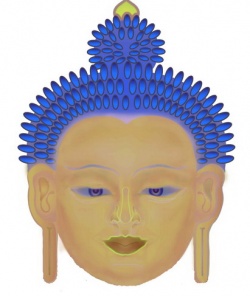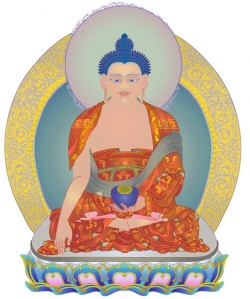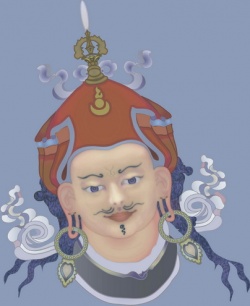Three turnings of the wheel of dharma
The Three Turnings of the Wheel (of Dharma) refers to a framework for understanding the sutra stream of the teachings of the Buddhism originally devised by the Yogachara school. It later became prevalent in modified form in Tibetan Buddhism and related traditions.
The distinction is, on the one hand, a historic or quasi-historic scheme by which the Buddha's first sermons, as recorded in the Pali Canon and the tripitakas of other early schools, constitute the First Turning, and the later Mahayana sutras comprise the Second and Third turnings. The schema appears in the Samdhinirmochana Sutra, a central Yogachara text, although it may predate it.
The tantras of the Vajrayana are generally not included under the rubric of the Three Turnings. The model of three turnings of the 'Wheel' is an attempt to categorize the content, philosophical view, and practical application of the whole array of Buddhist sutrayana teachings.
Contents of the Three Turnings
The basic content and audience of the three turnings of the wheel can be summarized as follows:
First Turning
The first turning is traditionally said to have taken place at Deer Park in Sarnath near Varanasi in northern India near Nepal, to an audience of shravakas. It consisted of the teaching of the Four Noble Truths (Sanskrit: catvāry āryasatyāni and the other elements of the Tripitaka – the Abhidharma, Sutrapitaka and Vinaya. The Abhidharma referred to is the Abhidharma Pitaka of the Sarvastivada school, which is a later composition not taught by the Buddha, and contains philosophy which is antithetical, one may say, to the early teachings.
Second Turning
The second turning is said to have taken place at Vulture Peak Mountain in Rajagriha, in Bihar, India. The audience comprised bodhisattvas; in some telling there were also shravaka arhats there as well, who promptly had heart attacks and died from the shock of the new teachings. In the second turning, the emphasis is on emptiness (Skt: śūnyāta) as epitomized in the Prajnaparamita sutras, and on compassion (Skt: karuṇā). These two elements form bodhicitta, the epitome of the second turning. The Madhyamika school that Nagarjuna founded arose from his exegesis of the early texts and is included under the second turning. Nagarjuna attacked the metaphysics of the Sarvastivada school and a school which broke away from it called Sautrantika, and promoted, among other things, the classical emphasis on the dependent arising of phenomena of the early texts.
Third Turning
The third turning was also delivered to an audience of bodhisattvas in Shravasti and other Indian locations (e.g. in Kusinagara, to Bodhisattvas and onlooking Buddhas, in the Mahaparinirvana Sutra) – or even in transcendental Buddhic realms (in the Avatamsaka Sutra). The focal point of the third turning is Buddha nature and particularly the Tathāgatagarbha doctrine. This was elaborated on in great detail by Maitreya via Asanga in the Five Treatises of Maitreya, which are also generally grouped under the third turning. The Yogachara school reoriented later refinements, in all their complexity, so as to accord with the doctrines of earliest Buddhism.
Fourth Turning
The Huayen school of Chinese Buddhism considered the Tathāgatagarbha doctrine a fourth turning, with the third turning comprising only the Yogachara school. In addition, Vajrayana schools sometimes refer to tantra as the "fourth turning."
Definitive and provisional
The schema of the three turnings is found in Yogachara and Tathāgatagarbha texts such as the Samdhinirmochana Sutra and the Srimala Sutra and likely originated in the Yogachara literature. Naturally, they identify themselves as definitive. However, the schema was later adopted more widely, and different sects and schools of Buddhism, as well as individual Buddhist teachers and philosophers give different explanations as to whether the second or third turnings is 'definitive' (Skt: nitartha) or 'provisional' (Skt: neyartha) or requiring interpretation. In the Tibetan tradition, the Gelug school considers the second turning definitive, as do some scholars in other schools.


